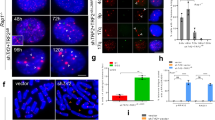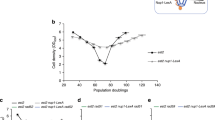Abstract
Telomeres protect the normal ends of chromosomes from being recognized as deleterious DNA double-strand breaks. Recent studies have uncovered an apparent paradox: although DNA repair is prevented, several proteins involved in DNA damage processing and checkpoint responses are recruited to telomeres in every cell cycle and are required for end protection1. It is currently not understood how telomeres prevent DNA damage responses from causing permanent cell cycle arrest. Here we show that fission yeast (Schizosaccharomyces pombe) cells lacking Taz1, an orthologue of human TRF1 and TRF2 (ref. 2), recruit DNA repair proteins (Rad22RAD52 and Rhp51RAD51, where the superscript indicates the human orthologue) and checkpoint sensors (RPA, Rad9, Rad26ATRIP and Cut5/Rad4TOPBP1) to telomeres. Despite this, telomeres fail to accumulate the checkpoint mediator Crb253BP1 and, consequently, do not activate Chk1-dependent cell cycle arrest. Artificially recruiting Crb253BP1 to taz1Δ telomeres results in a full checkpoint response and cell cycle arrest. Stable association of Crb253BP1 to DNA double-strand breaks requires two independent histone modifications: H4 dimethylation at lysine 20 (H4K20me2) and H2A carboxy-terminal phosphorylation (γH2A)3,4,5. Whereas γH2A can be readily detected, telomeres lack H4K20me2, in contrast to internal chromosome locations. Blocking checkpoint signal transduction at telomeres requires Pot1 and Ccq1, and loss of either Pot1 or Ccq1 from telomeres leads to Crb253BP1 foci formation, Chk1 activation and cell cycle arrest. Thus, telomeres constitute a chromatin-privileged region of the chromosomes that lack essential epigenetic markers for DNA damage response amplification and cell cycle arrest. Because the protein kinases ATM and ATR must associate with telomeres in each S phase to recruit telomerase6, exclusion of Crb253BP1 has a critical role in preventing telomeres from triggering cell cycle arrest.
This is a preview of subscription content, access via your institution
Access options
Subscribe to this journal
Receive 51 print issues and online access
$199.00 per year
only $3.90 per issue
Buy this article
- Purchase on Springer Link
- Instant access to full article PDF
Prices may be subject to local taxes which are calculated during checkout




Similar content being viewed by others
References
de Lange, T. How telomeres solve the end-protection problem. Science 326, 948–952 (2009)
Li, B., Oestreich, S. & de Lange, T. Identification of human Rap1: implications for telomere evolution. Cell 101, 471–483 (2000)
Du, L.-L., Nakamura, T. M. & Russell, P. Histone modification-dependent and -independent pathways for recruitment of checkpoint protein Crb2 to double-strand breaks. Genes Dev. 20, 1583–1596 (2006)
Greeson, N. T., Sengupta, R., Arida, A. R., Jenuwein, T. & Sanders, S. L. Di-methyl H4 lysine 20 targets the checkpoint protein Crb2 to sites of DNA damage. J. Biol. Chem. 283, 33168–33174 (2008)
Nakamura, T. M., Du, L.-L., Redon, C. & Russell, P. Histone H2A phosphorylation controls Crb2 recruitment at DNA breaks, maintains checkpoint arrest, and influences DNA repair in fission yeast. Mol. Cell. Biol. 24, 6215–6230 (2004)
Moser, B. A., Subramanian, L., Khair, L., Chang, Y.-T. & Nakamura, T. M. Fission yeast Tel1ATM and Rad3ATR promote telomere protection and telomerase recruitment. PLoS Genet. 5, e1000622 (2009)
Ferreira, M. G. & Cooper, J. P. The fission yeast Taz1 protein protects chromosomes from Ku-dependent end-to-end fusions. Mol. Cell 7, 55–63 (2001)
Ferreira, M. G. & Cooper, J. P. Two modes of DNA double-strand break repair are reciprocally regulated through the fission yeast cell cycle. Genes Dev. 18, 2249–2254 (2004)
Miller, K. M., Rog, O. & Cooper, J. P. Semi-conservative DNA replication through telomeres requires Taz1. Nature 440, 824–828 (2006)
Rog, O., Miller, K. M., Ferreira, M. G. & Cooper, J. P. Sumoylation of RecQ helicase controls the fate of dysfunctional telomeres. Mol. Cell 33, 559–569 (2009)
Tomita, K. et al. Fission yeast Dna2 is required for generation of the telomeric single-strand overhang. Mol. Cell. Biol. 24, 9557–9567 (2004)
Churikov, D. & Price, C. M. Pot1 and cell cycle progression cooperate in telomere length regulation. Nature Struct. Mol. Biol. 15, 79–84 (2007)
Denchi, E. L. & de Lange, T. Protection of telomeres through independent control of ATM and ATR by TRF2 and POT1. Nature 448, 1068–1071 (2007)
Guo, X. et al. Dysfunctional telomeres activate an ATM-ATR-dependent DNA damage response to suppress tumorigenesis. EMBO J. 26, 4709–4719 (2007)
Moser, B. A. et al. Differential arrival of leading and lagging strand DNA polymerases at fission yeast telomeres. EMBO J. 28, 810–820 (2009)
Verdun, R. E., Crabbe, L., Haggblom, C. & Karlseder, J. Functional human telomeres are recognized as DNA damage in G2 of the cell cycle. Mol. Cell 20, 551–561 (2005)
Mochida, S. et al. Regulation of checkpoint kinases through dynamic interaction with Crb2. EMBO J. 23, 418–428 (2004)
Sanders, S. L. et al. Methylation of histone H4 lysine 20 controls recruitment of Crb2 to sites of DNA damage. Cell 119, 603–614 (2004)
Wang, Y. & Jia, S. Degrees make all the difference: the multifunctionality of histone H4 lysine 20 methylation. Epigenetics 4, 273–276 (2009)
Chikashige, Y. & Hiraoka, Y. Telomere binding of the Rap1 protein is required for meiosis in fission yeast. Curr. Biol. 11, 1618–1623 (2001)
Miller, K. M., Ferreira, M. G. & Cooper, J. P. Taz1, Rap1 and Rif1 act both interdependently and independently to maintain telomeres. EMBO J. 24, 3128–3135 (2005)
Tomita, K. & Cooper, J. P. Fission yeast Ccq1 is telomerase recruiter and local checkpoint controller. Genes Dev. 22, 3461–3474 (2008)
Miyoshi, T., Kanoh, J., Saito, M. & Ishikawa, F. Fission yeast Pot1-Tpp1 protects telomeres and regulates telomere length. Science 320, 1341–1344 (2008)
Michelson, R. J., Rosenstein, S. & Weinert, T. A telomeric repeat sequence adjacent to a DNA double-stranded break produces an anticheckpoint. Genes Dev. 19, 2546–2559 (2005)
Abdallah, P. et al. A two-step model for senescence triggered by a single critically short telomere. Nature Cell Biol. 11, 988–993 (2009)
Hirano, Y. & Sugimoto, K. Cdc13 telomere capping decreases Mec1 association but does not affect Tel1 association with DNA ends. Mol. Biol. Cell 18, 2026–2036 (2007)
Negrini, S., Ribaud, V., Bianchi, A. & Shore, D. DNA breaks are masked by multiple Rap1 binding in yeast: implications for telomere capping and telomerase regulation. Genes Dev. 21, 292–302 (2007)
Botuyan, M. V. et al. Structural basis for the methylation state-specific recognition of histone H4-K20 by 53BP1 and Crb2 in DNA repair. Cell 127, 1361–1373 (2006)
Goudsouzian, L. K., Tuzon, C. T. & Zakian, V. A. S. cerevisiae Tel1p and Mre11p are required for normal levels of Est1p and Est2p telomere association. Mol. Cell 24, 603–610 (2006)
Verdun, R. E. & Karlseder, J. The DNA damage machinery and homologous recombination pathway act consecutively to protect human telomeres. Cell 127, 709–720 (2006)
Bähler, J. et al. Heterologous modules for efficient and versatile PCR-based gene targeting in Schizosaccharomyces pombe . Yeast 14, 943–951 (1998)
Moreno, S., Klar, A. & Nurse, P. Molecular genetic analysis of fission yeast Schizosaccharomyces pombe . Methods Enzymol. 194, 795–823 (1991)
Khair, L., Subramanian, L., Moser, B. A. & Nakamura, T. M. Roles of heterochromatin and telomere proteins in regulation of fission yeast telomere recombination and telomerase recruitment. J. Biol. Chem. 285, 5327–5337 (2010)
Acknowledgements
We thank J. Cooper, K. Tomita and the rest of the Telomere Biology Laboratory (Cancer Research UK, London) for support at the start of this project. We thank J. Cooper, T. Wolkow, P. Russell and A. M. Carr for strains and plasmids. We thank W. Kaufman for her initial effort in the establishment of HO strains. We are grateful to S. Grewal for sharing unpublished results and to D. Lydall for insights on the quantitative analysis of checkpoint activation. We thank K. Labib, L. Jansen, K. Xavier, R. Martinho and S. Lopes for critically reading the manuscript. T.C. and C.C.R. are supported by Fundação para a Ciência e a Tecnologia (FCT) postdoctoral fellowships. T.M.N. was supported by the Sidney Kimmel Scholar Program and his laboratory is supported by NIH grant GM078253. This work was supported by the FCT (PTDC/BIA-BCM/67261/2006) and the Association for International Cancer Research (06-396).
Author information
Authors and Affiliations
Contributions
T.C. helped with the design and executed most experiments. L.K. performed ChIP experiments. C.C.R. performed western and Southern blotting experiments. V.B. performed live cell analysis. B.A.M. established the ChIP and HO assays. T.M.N. contributed to the design of the ChIP and HO assays. All authors contributed with strains and data analysis. M.G.F. conceived the study, performed live cell analysis and wrote the paper.
Corresponding author
Ethics declarations
Competing interests
The authors declare no competing financial interests.
Supplementary information
Supplementary Information
This file contains Supplementary Figures 1-6 with legends and Supplementary Tables 1-2. (PDF 924 kb)
Rights and permissions
About this article
Cite this article
Carneiro, T., Khair, L., Reis, C. et al. Telomeres avoid end detection by severing the checkpoint signal transduction pathway. Nature 467, 228–232 (2010). https://doi.org/10.1038/nature09353
Received:
Accepted:
Issue Date:
DOI: https://doi.org/10.1038/nature09353
This article is cited by
-
A subtelomeric region affects telomerase-negative replicative senescence in Saccharomyces cerevisiae
Scientific Reports (2019)
-
i-Motif DNA structures upon electric field exposure: completing the map of induced genetic errors
Theoretical Chemistry Accounts (2019)
-
Biosemantics guided gene expression profiling of Sjögren’s syndrome: a comparative analysis with systemic lupus erythematosus and rheumatoid arthritis
Arthritis Research & Therapy (2017)
-
Structure of the fission yeast S. pombe telomeric Tpz1-Poz1-Rap1 complex
Cell Research (2017)
-
Systematic analysis of human telomeric dysfunction using inducible telosome/shelterin CRISPR/Cas9 knockout cells
Cell Discovery (2017)
Comments
By submitting a comment you agree to abide by our Terms and Community Guidelines. If you find something abusive or that does not comply with our terms or guidelines please flag it as inappropriate.



